
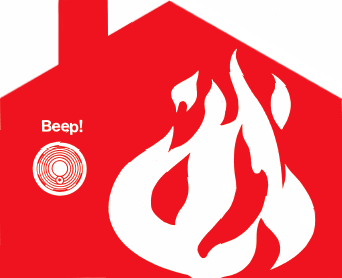
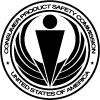



Sources Of Fire
Supplemental Home
Heating Equipment
Cooking Equipment
Cigarette Lighters and
Matches
Materials That
Burn
Upholstered
Furniture
Mattresses
and Bedding
Wearing Apparel
Flammable
Liquids
Early Warning
and Escape
Smoke Detectors
Escape Plan
This publication is in the public domain and it may be reproduced in whole or in part without permission. We encourage photocopying or reprinting this information.
This Home Fire Safety Checklist was developed by the U.S. Consumer Product Safety Commission (CPSC), an independent regulatory agency of the U.S. Government.
The Commission has four statutory missions:
It has jurisdiction over more than 15,000 consumer products used in the home, school and in public places. Among the products not subject to the Commission's authority are food, drugs, automobiles, tobacco, and fire arms. The Commission administers five safety laws: The Consumer Product Safety Act, the Federal Hazardous Substances Act, the Flammable Fabrics Act, the Poison Prevention Packaging Act, and the Refrigerator Act.
CPSC began operation on May 14, 1973. It is headed by three Commissioners appointed by the President with the advice and consent of the Senate.
On October 29, 1973, the Commission instituted a toll-free Hotline to make it easier for consumers to report product-related injuries or potentially hazardous products, and to get information on recalled products seven days a week, 24 hours a day. You may call the Commission's Hotline from anywhere in the continental U.S. by dialing 1-800-638-2772. A teletypewriter for the hearing impaired is also available (including Alaska and Hawaii) on a special Hotline number 1-800-638-8270. To order publications, write to the Office of Information and Public Affairs, Washington. DC 20207.
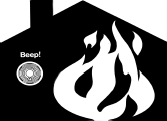
The United States has one of the highest fire death and injury rates in the world. Fire -- in the form of flames and smoke -- is the second leading cause of accidental death in the home.
More than 4,000 people die each year in home fires. Every year, there are more than 500,000 residential fires serious enough to be reported to fire departments. More than 90 percent of residential fire deaths and injuries result from fires in one and two family houses and apartments. Property losses exceed 4 billion dollars annually, and the long term emotional damage to victims and their loved ones is incalculable.
The U.S. Consumer Product Safety Commission (CPSC) has targeted the principal consumer products associated with fires, namely home heating devices, upholstered furniture, bedding, cigarette lighters, matches, and wearing apparel. The Commission is participating in a special Congressionally authorized study of cigarette-ignited fires, which cause more deaths than any other kind of fire. The Commission continues to push for extensive use of smoke detectors. With the help of concerned consumers, the number or residential fires has declined about 30 percent since 1980.
The CPSC is fulfilling its role to make products inherently more fire safe. We recognize that much more can be done to cut down on the needlessly high and tragic fire toll by an alert and informed public. Many of the injuries associated with flammable products result from hazards that are overlooked. Fire experts agree that one key to fewer fires is a greater awareness of how accidents can be prevented. By spotting these hazards and taking some simple precautions, many fires and fire-related injuries can be prevented.
Use this checklist as a safety guide to spot possible fire safety problems which may be present in your home. It is a first step in reducing the risk of fire. Check YES or NO to answer each question. If you check NO to any question, the potential hazard should be corrected to avoid the risk of injury or death.
How safe is your home from fire?
PRODUCT SAFETY, IT'S NO ACCIDENT!
The use of supplemental room heaters, such as wood and coal burning stoves, kerosene heaters, gas space heaters and electrical heaters, has decreased, along with the number of residential fires.
Even though there has been a decrease in fires associated with supplemental heaters, it is important to remember that about 120,000 residential fires still occur annually with the use of these heaters, or about 22 percent of all residential fires. These fires kill more than 600 people. Annually there are thousands of contact burn injuries and hundreds of carbon monoxide poisonings.
You should be able to respond "yes" to the following safety statements.
| Yes | No | ||
|---|---|---|---|
| 1. | The wood stove or fireplace has been installed according to existing building codes and manufacturer's instructions. | ___ | ___ |
| 2. | The chimney and stovepipe are checked frequently during the heating season for creosote buildup and are cleaned when necessary. | ___ | ___ |
| 3. | The stove sits on a non-combustible or on a code-specified or listed floor protector. | ___ | ___ |
| 4. | Combustibles such as curtains, chairs, firewood, etc., are at least three feet away from the stove. | ___ | ___ |
| 5. | Only proper fuel is used in the stove. | ___ | ___ |
| 6. | A metal container with a tight-fitting lid is used for ash removal. | ___ | ___ |
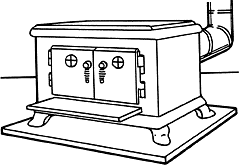
You should be able to respond "yes" to the following safety statements.
| Yes | No | ||
|---|---|---|---|
| 1. | Only 1-K kerosene is used and it is bought from a dealer who can certify that the product is 1-K kerosene. | ___ | ___ |
| 2. | The heater is placed out of the path of traffic areas such as doorways and hallways. | ___ | ___ |
| 3. | Kerosene is stored outdoors, and out of the reach of children in a tightly sealed, preferably blue plastic or metal container, labeled "kerosene." | ___ | ___ |
| 4. | No attempt is to be made to move the heater if flare-up (flames outside the heater cabinet) occurs. The fire department is called immediately. | ___ | ___ |
| 5. | The heater is used in well ventilated rooms. | ___ | ___ |
| 6. | The heater is turned off while sleeping and is never left operating unattended. | ___ | ___ |
| 7. | The heater is placed at least three feet away from anything that might catch fire such as clothing, furniture, curtains, etc. | ___ | ___ |

You should be able to respond "yes" to the following safety statements.
| Yes | No | ||
|---|---|---|---|
| 1. | Only vented heaters are installed or used in sleeping quarters. | ___ | ___ |
| 2. | Vented heaters are properly vented to the outside. | ___ | ___ |
| 3. | The unvented gas-fired room heater has a warning label and instructions that are followed. | ___ | ___ |
| 4. | The unvented gas-fired room heater has a label stating it has a "pilot safety system", which turns off the gas if not enough fresh air is available. | ___ | ___ |
| 5. | The vented heater has a label stating that it is equipped with a vent safety shutoff system. | ___ | ___ |
| 6. | If the heater uses liquefied petroleum (LP) gas, the container is located outside the house. | ___ | ___ |
| 7. | The manufacturer's instructions for lighting the pilot are followed. | ___ | ___ |
| 8. | Matches are lighted before turning on the gas if pilot lighting is required. | ___ | ___ |
| 9. | Flammable materials and liquids are kept away from gas heating appliances. | ___ | ___ |
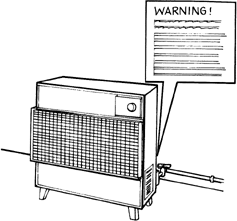
The Commission estimates that half the deaths and one-third of the injuries resulting from electric heater fires occurred at night when family members were asleep and the heater unattended. The Commission is also concerned about the use of power or extension cords which can be too small to supply the amount of current required by the typical portable electric heater.
You should be able to respond "yes" to the following safety statements.
| Yes | No | ||
|---|---|---|---|
| 1. | The heater is operated at least three feet away from upholstered furniture, drapes, bedding and other combustible materials. | ___ | ___ |
| 2. | The extension cord (if used) is marked #14 or #12 American Wire Gauge (AWG). | ___ | ___ |
| 3. | The heater is used on the floor. | ___ | ___ |
| 4. | The heater is turned off when family members leave the house or are sleeping. | ___ | ___ |
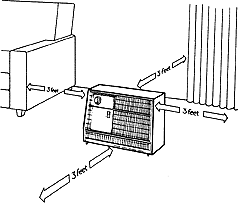
Cooking equipment is estimated to be associated with more than 100,000 fires annually, and almost 400 deaths, and 5,000 injuries. Gas cooking equipment accounts for about 30,000 fires, and electric cooking equipment for about 55,000 fires.
You should be able to respond "yes" to the following safety statements.
| Yes | No | ||
|---|---|---|---|
| 1. | The storage area above the stove is free of flammable and combustible items. | ___ | ___ |
| 2. | Short or tight fitting sleeves, and tight fitting shirts, robes, gowns, etc., are worn while cooking. | ___ | ___ |
| 3. | Items that could attract children (e.g. cookies and candy) are not kept above the range and are kept out of the immediate area. | ___ | ___ |
| 4. | The stove is not left unattended when cooking especially when the burner is turned to a high setting. | ___ | ___ |
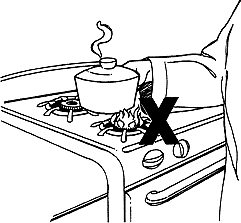
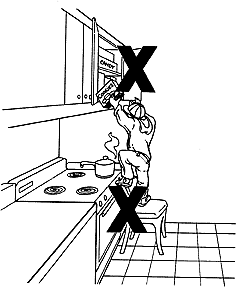
Each year more than 200 deaths are associated with fires statreted by cigarette lighters. About two thirds of these result from children playing with lighters. Most of the victims are under five years old.
You should be able to answer "yes" to the safety statements below.
| Yes | No | ||
|---|---|---|---|
| 1. | Cigarette lighters and matches are kept out of the reach of children | ___ | ___ |
| 2. | Cigarette lighters are never used to entertain a child. | ___ | ___ |
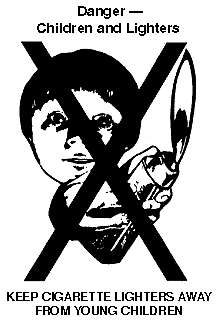
Your home is filled with materials and products that will burn if ignited. Upholstered furniture, clothing, drapery fabrics, and liquids such as gasoline and volatile solvents are involved in many injury-causing fires each year. Most of these fires could be prevented.
In 1989, there were 18,600 residential fires associated with upholstered furniture; about 900 people lost their lives. About one half of these fires were caused by smoking materials. Property losses amounted to over $ 100 million from fires started by cigarette ignition of upholstered furniture.
You should be able to respond "yes" to the safety statements below.
| Yes | No | ||
|---|---|---|---|
| 1. | Upholstered furniture fabrics made from vinyl, wool or thermoplastic fibers are generally selected for safety reasons. | ___ | ___ |
| 2. | I check thoroughly after parties for ashes or unextinguished cigarettes that may have fallen behind and between cushions and under furniture. | ___ | ___ |
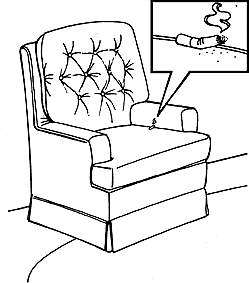
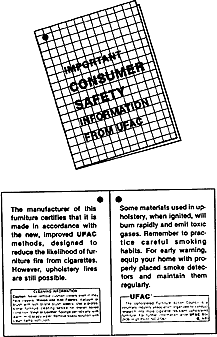
Smoldering fires in mattresses and bedding materials caused by cigarettes are a major cause of deaths in residential fires. In 1989 over 35,000 mattress/bedding fires caused about 700 deaths.
You should be able to respond "yes" to the following safety statements.
| Yes | No | ||
|---|---|---|---|
| 1. | "No smoking in bed" is a rule that is practiced in my home. | ___ | ___ |
| 2. | Heaters, ash trays, smoking materials and other fire sources are located away from bedding. | ___ | ___ |
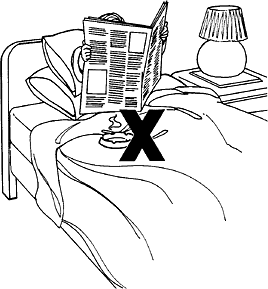
Most fibers used in clothing can burn, some more quickly than others. A significant number of clothing fires occur in the over 65 age group principally from nightwear (robes, pajamas, nightgowns). In 1989 about 200 clothing fire deaths were reported; about three fourths occurred in the 65 and older age group. The severity of apparel burns is high. Hospital stays average over one month.
Small open flames, including matches, cigarette lighters, and candles are the major sources of clothing ignition. These are followed by ranges, open fires and space heaters. The most commonly worn garments that are associated with clothing ignition injuries are pajamas, nightgowns, robes, shirts/blouses, pants/slacks and dresses.
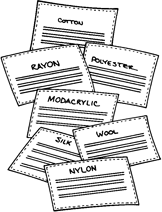
You should be able to respond "yes" to the following statements.
| Yes | No | ||
|---|---|---|---|
| 1. | When purchasing wearing apparel I consider fiber content and fabric construction for safety purposes. | ___ | ___ |
| 2. | I purchase garments for my children that are intended for sleepwear since they are made to be flame resistant. | ___ | ___ |
One of the major causes of household fires is flammable liquids. These include gasoline, acetone benzene, lacquer thinner, alcohol, turpentine, contact cements, paint thinner, kerosene, and charcoal lighter fluid. The most dangerous of all is gasoline.
You should be able to respond "yes" to the following safety statements.
| Yes | No | ||
|---|---|---|---|
| 1. | Flammable liquids are stored in properly labeled, tightly closed non-glass containers. | ___ | ___ |
| 2. | These products are stored away from heaters, furnaces, water heaters, ranges, and other gas appliances. | ___ | ___ |
| 3. | Flammable liquids are stored out of reach of children. | ___ | ___ |
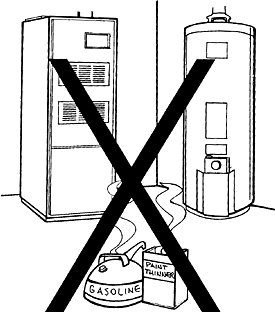
Even when you have complied with every item in this Home Fire Safety Checklist, you still need to have a plan for early warning and escape in case a fire does occur.
Many fire deaths and fire injuries are actually caused by smoke and gases. Victims inhale smoke and poisonous gases that rise ahead of the flames. Survival depends on being warned as early as possible and having an escape plan.
You should be able to respond "yes" to the following statements.
| Yes | No | ||
|---|---|---|---|
| 1. | At least one smoke detector is located on every floor of my home. | ___ | ___ |
| 2. | Smoke detectors are placed near bedrooms, either on the ceiling or 6-12 inches below the ceiling on the wall. | ___ | ___ |
| 3. | Smoke detectors are tested according to manufacturer's instructions on a regular basis (at least once a month) and are kept in working condition at all times. | ___ | ___ |
| 4. | Batteries are replaced according to manufacturer's instructions, at least annually. | ___ | ___ |
| 5. | Batteries are never disconnected. | ___ | ___ |
| 6. | The detector has a distinct warning signal that can be heard whether asleep or awake. | ___ | ___ |
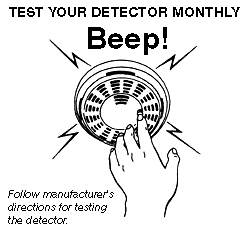
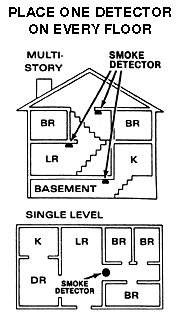
Make sure detectors are placed either on the ceiling or 6-12 inches below the ceiling on the wall. Locate smoke detectors away from air vents or registers; high air flow or "dead" spots are to be avoided.
Planning ahead, rehearsing, thinking, and acting clearly are keys to surviving a fire. How prepare are you?
You should be able to respond "yes" to the following statements.
| Yes | No | ||
|---|---|---|---|
| 1. | The family has an escape plan and an alternate escape plan. | ___ | ___ |
| 2. | Escape routes and plans are rehearsed periodically. | ___ | ___ |
| 3. | The escape plan includes choosing a place safely outside the house where the family can meet to be sure everyone got out safely. | ___ | ___ |
| 4. | At least two exits from each part of the house are established. | ___ | ___ |
| 5. | The fire department number is posted on every telephone. | ___ | ___ |
Establish advanced family planning for escape. It is an important partner with smoke detectors and it will prepare you for a fire emergency.
Include small children as a part of the discussion and rehearsal. It is especially important to make sure they understand that they must escape; they can't hide from fire under a bed or in a closet.
Your life and that of your family can be saved by foresight, planning, discussing and rehearsal.
PRODUCT SAFETY, IT'S NO ACCIDENT!
U.S. CONSUMER PRODUCT SAFETY COMMISSION
Washington, DC 20207
Web site: www.cpsc.gov
Toll-free hotline: 1-800-638-2772
The U.S. Consumer
Product Safety Commission (CPSC) is a federa1 agency that helps
keep families and children safe in and around their homes.
For more information,
call the CPSC’s toll-free hotline 1-800-638-2772
or visit its website at http://www.cpsc.gov.
To report a product hazard or a product related injury, write to the U.S. Consumer Product Safety Commission, Washington, D.C. 20207. In the United States, call the toll free hotline: 800-638-CPSC (2772). A teletypewriter for the deaf is available on the following numbers: National (including Alaska and Hawaii) 800-638-8270. CPSC news releases, Public Calendar and other information can be obtained via the Internet from the agency’s Web Site: http://www.cpsc.gov Agency staff may be contacted by e-mail: E-mail Address: info@cpsc.gov.
This document is in the public domain. It may be reproduced in part or in whole by an individual or organization without permission. If it is reproduced, however, the Commission would appreciate knowing how it is used. Write the U.S. Consumer Product Safety Commission, Office of Information and Public Affairs, Washington, D.C. 20207.
The U.S. Consumer Product Safety Commission (CPSC) is an independent regulatory agency charged with reducing unreasonable risks of injury associated with consumer products. CPSC is headed by three Commissioners appointed by the President with the advice and consent of the Senate.
PRODUCT SAFETY, IT’S NO ACCIDENT.
U.S. Consumer
Product Safety Commission
Eastern Region
Eastern Regional Center
201 Varick Street, Room 903
New York, NY 10014-4811
(212) 620-4120
U.S. Consumer
Product Safety Commission
Central Region
Central Regional Center
230 South Dearborn Street, Room 2944
Chicago, IL 60604-1601
(312) 353-8260
U.S. Consumer
Product Safety Commission
Western Region
Western Regional Center
1301 Clay Street, Suite 610-N
Oakland, CA 94612
(510) 637-4050
---
Send the link for this page to a friend! Consumers can obtain this publication and additional publication information from the Publications section of CPSC's web site or by sending your publication request to info@cpsc.gov.
This document is in the public domain. It may be reproduced without change in part or whole by an individual or organization without permission. If it is reproduced, however, the Commission would appreciate knowing how it is used. Write the U.S. Consumer Product Safety Commission, Office of Information and Public Affairs, Washington, D.C. 20207 or send an e-mail to info@cpsc.gov.
The U.S. Consumer Product Safety Commission is charged with protecting the public from unreasonable risks of serious injury or death from more than 15,000 types of consumer products under the agency's jurisdiction. Deaths, injuries and property damage from consumer product incidents cost the nation more than $700 billion annually. The CPSC is committed to protecting consumers and families from products that pose a fire, electrical, chemical, or mechanical hazard or can injure children. The CPSC's work to ensure the safety of consumer products - such as toys, cribs, power tools, cigarette lighters, and household chemicals - contributed significantly to the 30 percent decline in the rate of deaths and injuries associated with consumer products over the past 30 years.
To report a dangerous product or a product-related injury, call CPSC's hotline at (800) 638-2772 or CPSC's teletypewriter at (800) 638-8270, or visit CPSC's web site at www.cpsc.gov/talk.html. To join a CPSC email subscription list, please go to www.cpsc.gov/cpsclist.asp. Consumers can obtain this release and recall information at CPSC's Web site at www.cpsc.gov.
---
Send the link for this page to a friend! Consumers can obtain this publication and additional publication information from the Publications section of CPSC's web site or by sending your publication request to info@cpsc.gov.
This document is in the public domain. It may be reproduced without change in part or whole by an individual or organization without permission. If it is reproduced, however, the Commission would appreciate knowing how it is used. Write the U.S. Consumer Product Safety Commission, Office of Information and Public Affairs, Washington, D.C. 20207 or send an e-mail to info@cpsc.gov.
The U.S. Consumer Product Safety Commission is charged with protecting the public from unreasonable risks of serious injury or death from more than 15,000 types of consumer products under the agency's jurisdiction. Deaths, injuries and property damage from consumer product incidents cost the nation more than $700 billion annually. The CPSC is committed to protecting consumers and families from products that pose a fire, electrical, chemical, or mechanical hazard or can injure children. The CPSC's work to ensure the safety of consumer products - such as toys, cribs, power tools, cigarette lighters, and household chemicals - contributed significantly to the 30 percent decline in the rate of deaths and injuries associated with consumer products over the past 30 years.
To report a dangerous product or a product-related injury, call CPSC's hotline at (800) 638-2772 or CPSC's teletypewriter at (800) 638-8270, or visit CPSC's web site at www.cpsc.gov/talk.html. To join a CPSC email subscription list, please go to www.cpsc.gov/cpsclist.asp. Consumers can obtain this release and recall information at CPSC's Web site at www.cpsc.gov.